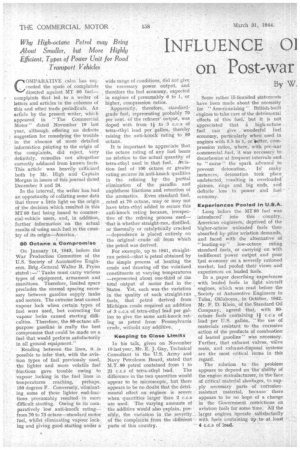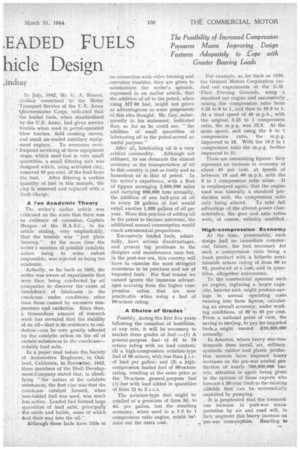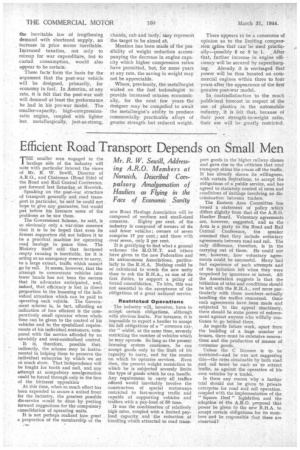INFLUENCE 01 ,EADED FUELS
Page 26

Page 27

Page 28

If you've noticed an error in this article please click here to report it so we can fix it.
on Post-war hide Design
By W,
,indsay
COMPARATIVE calm has succeeded the spate of complaints directed against MT 80 fuel— complaints that led to a welter, of letters and articles in the columns of
this and other trade periodicals. An article by the present writer, which appeared in "The Commercial Motor" dated November 19 last year, although offering no definite . suggestion for remedying the trouble • in the absence of more detailed information pointing to the origin of the complaints, did reject, very definitely, remedies not altogether correctly adduced from known facts. This article was heavily criticized both by Mr. High and Captain Morgan in issues of this journal dated December 3 and 24. • In the interval, the writer has had an opportunity of collating some data that throw a little light on the origin of the decision which resulted in this MT 80 fuel being issued to commercial-vehicle users, and, in addition, further information on the actual results of using such 'fuel in the country of its origin—America.
80 Octane a Compromise On January 14, 1943, before the War Production Committee of the U.S. Society of Automotive Engineers, Brig.-General Walter B. Pryon stated :—" Tanks must carry various types of equipment, armament and munitions. Therefore, limited space precludes the normal spacing necessary between gasoline supply tanks and motors. The extreme heat caused vapour lock when certain types of fuel were used, but correcting for vapour locks caused starting' difficulties. Therefore, the 80-octane allpurpose gasoline is really the best compromise that could be made on a fuel that would perform satisfactorily in all ground equipment."
Reading between 'the lines, it is possible to infer that, with the aviation types of fuel previously used, the lighter and more volatile fuel• fractions gave trouble owing to vapour locking in the fuel lines in temperatures reaching, perhaps, 150 degrees F. Conversely, 'eliminating, some of these lighter end-fractions presumably resulted in more difficult starting. Owing to its comparatively low anti-knoCk rating— from 70 to 73 octane—standard motor fuel, whilst eliminating vapour loCking and giving good starting under a wide range of conditions, did not give the necessary power output, and , therefore the fuel economy, expected in engines of presumably 6 to 1, or higher, compression ratios.
Apparently, therefore, standardgrade fuel, representing probably 70 per cent, of the refiners output, was doped with from 11to $ c.c.s of tetra-ethyl lead per gallon, thereby raising the anti-knock rating to 80 octane.
It is important to appreciate that the octane rating of any fuel bears no relation to the actual quantity of tetra-ethyl used in that fuel. Aviation fuel of 100 octane or greater rating secures its anti-knock qualities in the refining by the partial elimination of the paraffin and naphthene fractions and retention of the aromatics. Even standard fuel, . rated at 70 octane, may or may not have tetra-ethyl added to secure this anti-knock rating because, irrespective of' the refining process used— 'that is whether straight-run, distilled, or thermally or catalytiCally cracked --dependence is placed entirely on the original' crude oil from which the petrol was derived.
For example, up to 1941, straightrun petrol—that is petrol obtained by the simple process of heating the crude and drawing off the volatized constituents at varying temperatures —represented about one-third of the total output of motor fuel in the 'States. Yet, such was the variation in the quality of such straight-run fuels, that petrol derived from Michigan crude required an addition of 3 c.c.s of tetra-ethyl lead per gallon to give the same anti-knock rating. as petrol from Pennsylvania crude, withoht any additive.
Keeping to Close Limits
In his talk, given on November 19 last year, Mr. E. J. Gay, Technical ..Consultant to the U.S. Army and Navy Petroleum Board, stated that M.T. 80 petrol contained from 1 to 21' c.c.s of tetra-ethyl lead.' The difference in the two quantities would appear to be microscopic, but there appears to be no doubt that the detrimental effect on engines is severe when quantities larger than 2 c.c.s are used. The varying amounts of the additive Would also explain, possibly, the variation in the severity_ of 'the complaints from the 'different parts of this country. Some rather ill-founded statements have been made about the necessity for " Americanizing " British-built engines to take care of the detrimental effects of this fuel; but it is not appreciated that a high-octane fuel can give wonderful fuel economy, particularly when used in engines with 5.5 to 1, or-better, compression ratios, where, with pre-war commercial fuel, it was necessary to decarbonize at frequent intervals and to " nurse " the spark advance ..to prevent detonation. In" many instances, detonation took place undetected, resulting in overloaded' pistons, rings and big ends, and definite loss in power and fuel economy.
Experiences Pooled in U.S.A.
Long before the MT 80 fuel was introduced' into this country, American engineers, deprived of the higher-octane unleaded fuels then • absorl5ed by prior aviation demands, and faced with the alternative of " leading-up " low-octane rating standard fuels,, or carrying on with indifferent power output and poor fuel economy on a severely rationed market, had pooled their views and experiences on leaded fuels.
In a, paper describing experiences with leaded fuels in light aircraft engines, which was read before the , Society of Automotive Engineers in Tulsa, Oklahoma, in October, 1942, Mr. F. D. Klein, of the Standard Oil Company,, agreed that, with 80octane fuels containing 11 c.c.s of lead per U.S. gallon, " the use of materials resistant to' the corrosive action of the products of combustion of leaded gasoline" was necessary. Further, that exhaust valves, vilve seats, and exhaust-disposal systems are the most critical items in this regard.
The solution to the problem appears to depend on 'the ability of the engine manufacturers, in the face of critical material shortages, to supply necessary parts of cotrosionresistant material, becausethere appears to be no hope of a change in the Government restrictions on aviation fuels for some time. All the larger, engines Operate satisfactorily with fuels containing up to at least 4 c.c.s of lead. • • • • . In July, 1942, Mr. G. A. Round, civilian consultant to. the Motor Transport Service of the U.S. Army QUartermaster Corps, indicated that the leaded fuels, when standardized by the U.S. 'Army, had given service trouble when used in petrol-operated blow torches, field cooking stoves, and small air-Cooled auxiliary, equipment engines.To overcome over
'. frequent servicing of these equipment items, which used fuel in very small quantities, a small filtering unit was designed which, using activated clay, removed 99 per cent. Of the lead from
the -fuel. After filtering a certain quantity of -fuel in this manner, the clay is removed and• replaced with a fresh charge.
A TOO Academic Theory The writer's earlier article was criticized On the score that there was no evidence' of corrosion, Captain Morgan of the R.A.S.C., in his article stating, very emphatically, that the trouble was 'just plain burning." At the -same time the writer's mention of possible catalytic action being to smite extent responsible, was rejected as being too academic.
"Actually, so far back as 1932, the writer was aware of experiments that were then being conducted by oil companies to discover the cause of breakdown of lubricants in the crankcase under conditions other than those caused by excessive temperature and oxidation. Since then, a tremendous amount of research . work has revealed that the stability of an oil.-that is its resistance to.oxidation—can be very greatly .affected by the catalytic action on the oil of certain substances in the crankcase— notably lead salts.
In a paper read before the. Society of Automotive Engineers, in Oak. land, California, in November, 1942, three members of the Shell Develop. ment-Company stated that, in identifying "the nature of the catalytic substances, the first clue Was that the crankcase catalyst formed, when non-leided fuel was used, was much less active. Leaded fuel formed large quantities of lead salts, principally . theoxide and halide, some of 'which • find their way into the oil.',' Although these facts have little or
'no connection with valve burning and ,corrosion troubles, they are given to substantiate the writer's opinion, expressed in an earlier article, that the addition of oil to the petrol, when .n.;sing MT 80 fuel, might not prove as advantageous as some proponents of this idea thought. Mr. Gay, subse quently in his statement, indicated that, so far as he could see, " the addition of small quantities of lubricating oil to the petraserved no useful purpose," After all, lubrieating oil is a very criticalcommodity. Although not rationed, its use demands the utmost economy as the transportation of oil to this country is just as Costly and as hazardous as is that of petrol. In the writer's experience; with a fleet of tippers averaging 2,000,000 miles and carrying 600,000 tons annually,
the addition a one half-pint of oil to every 20 gallons of fuel would
entail. another 1,000 gallons of oil per year. Were this practice of adding oil to the petrol to become universal, the additional annual consumption would reach astronomical proportions.
Excessively leaded fuels, admittedly, . have serious disadvantages, and present big problems to the designer and maintenance man but, in the post-war era, this country will have to exercise the most stringent economies in its purchase and use of imported fuels. For that reason we cannot ignore the immense advantages accraing from the higher compression ratios that are now practicable when using a fuel of 80-octane rating.
A Choice of Grades
Possibly, during the first five years following the cessation of hostilities, at any rate, it will be necessary to market three grades of fuel :—(1) A general-purpose fuel. of 67 to 70 octane rating with no lead content; (2) a high-compression aviation-type fuel of 90 octane, with less than c.c. of lead per gallon; and (3) a highcompression leaded fuel of 80-octane rating, retailing at the same price as the 70-octane, general-purpose fuel (I) but with lead added in quantities of from 2h: to 3 c.c.s.
The aviation-type fuel might be retailed at a premium of from ad. to 4d. per, gallon, but the resulting economy, when used in a 7.5 to 1 compression ratio engine, might balance out the extra cost. For example, as far back as 1938, the General Motors Corporation Carried out experiments at the G.M. 'Flint Proving Grounds, using a standard car engine and successively raising the compression ratio from 5.25 to 8 to 1, and thert•to 10.3 to 1. At a road speed of 40 m.p.h., with the original 5.25to 1 compression ratio, the m.p.g. was 12.5. At the same speed, and using the 8 to 1 compression ratio, the m.,p.g. improved to 18. With the 10.3 to 1 compression ratio the m.p.k. further improved to 21. These are astonishing figures they represent an increase in economy of about 45 per 'cent. at speeds of between 10 and 60 m.p.h. with the 8 to 1 compression ratio alone. It is emphasized again, that the engine used was basically a standard production unit, the 'compression ratio only being altered. To take full advantage of the altered power characteristics, the gear and. axle ratios were, of course, suitably modified.
High-compression Economy " At the time, presumably, such design had no immediate cotnmercial future, the fuel necessary for such a compression ratio being a freak product with a hitherto unattainable octane rating of from .90 to 95, produced at a east, and in quantities, altogether uneconomic.
To the cominercial operator such an engine, replacing a larger caPacity, heavier unit, might produce savings in annual • operating costs tanning into three figures, calculating an overall econoniy, under working conditions, of 30 to $5 per cent. From a national point of view, the saving in sterling, to pay for imported fuels, at might exceed £50,090,000 annually. • • In America, where heavy war-time demands from naval, air, military, synthetic ribber and plastic production sources have imposed • heavy increases on the pre-war annuai production of nearly 700,000,000 barrels, attention is again .being given to the opinion of those experts who forecast a 20-year limit to the existing oilfields that can be economically exploited by pumping. • • It is prophesied that the tremendousincrease in post-war transportation by air and road will, in fact, augment this heavy increase on „" pre-war consumption. Reacting to
the inevitable law of lengthening demand with shortened supply, an increase in price seems inevitable. Increased taxation, not only to recoup for war expenditure, but to curtail consumption, would also appear to be certain.
These facts form the basis far the argument that the post-war vehicle will be designed, primarily, for economy in fuel. In America, at any rate, it is felt that the post-war user will demand at least the performance he had in his pre-war Model. The smaller-capacity, high-compressionratio engine, coupled with lighter but metallurgically, just-as-strong,
chassis, cab and body, may represent the target to be aimed at.
Mention has been made of the possibility of weight reduction accompanying the decrease in engine capacity which higher compression ratios have permitted, but, for some years at any rate, the saving in weight may not be appreciable.
Where, previously, the metallurgist waited on the fuel technologist to provide increased octanes economically, for the next few years the designer may be compelled to await the metallurgist's ability to produce commercially practicable alloys of greater strength but reduced weight. There appears to be a consensus of opinion as to the limiting compression ritios that can be Used practic ally—possibly 8 or 9 to I. After. that, further increase in engine efficiency will he secured by supercharg ing. Already it is envisaged that power will be thus boosted on commercial engines within three to four years after the appearance of the first genuine post-war model.
In contradistinction to the much publicized forecast in respect of the use of plastics in the automobile industry, it is felt that, because of their poor strength-to-weight ratio, their use will be greatly restricted.




















































